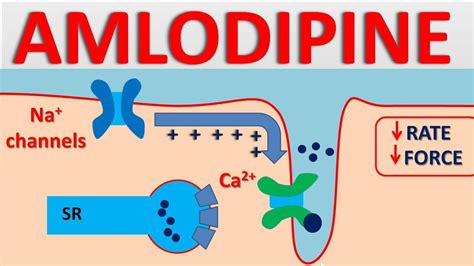Intro
Discover the uses and benefits of Amlodipine, a calcium channel blocker, for hypertension, angina, and coronary artery disease management, offering cardiovascular protection and improved heart health.
Amlodipine is a medication that has been widely used for decades to treat various cardiovascular conditions. It belongs to a class of drugs known as calcium channel blockers, which work by relaxing blood vessels and increasing blood flow to the heart. This medication has been a cornerstone in the management of hypertension, angina, and other cardiovascular diseases. In this article, we will delve into the uses and benefits of amlodipine, exploring its mechanisms, advantages, and potential side effects.
The importance of amlodipine lies in its ability to alleviate symptoms and improve quality of life for individuals suffering from cardiovascular conditions. By reducing blood pressure and increasing oxygen supply to the heart, amlodipine helps to mitigate the risk of heart attacks, strokes, and other cardiovascular events. Its effectiveness has made it a popular choice among healthcare professionals, with millions of prescriptions written worldwide every year. As we explore the uses and benefits of amlodipine, it becomes clear that this medication has revolutionized the treatment of cardiovascular diseases.
Amlodipine's impact on public health is significant, given the prevalence of cardiovascular conditions worldwide. According to the World Health Organization (WHO), cardiovascular diseases are the leading cause of death globally, accounting for over 17 million deaths per year. The use of amlodipine has been shown to reduce the risk of cardiovascular events, making it an essential tool in the prevention and management of these conditions. As we examine the benefits and uses of amlodipine, it is essential to consider the broader context of cardiovascular health and the role that this medication plays in promoting overall well-being.
Amlodipine Mechanism of Action

The benefits of amlodipine are numerous, with the medication offering a range of advantages over other treatments. Some of the key benefits include:
- Reduced blood pressure: Amlodipine has been shown to lower blood pressure in individuals with hypertension, reducing the risk of cardiovascular events.
- Increased oxygen supply: By dilating coronary arteries, amlodipine increases oxygen supply to the heart, reducing the frequency of angina attacks.
- Improved quality of life: Amlodipine has been shown to improve quality of life for individuals with cardiovascular conditions, reducing symptoms and improving overall well-being.
Amlodipine Uses

Amlodipine Dosage and Administration
Amlodipine is typically administered orally, with dosages ranging from 2.5 to 10 mg per day. The medication is usually taken once daily, with or without food. It is essential to follow the prescribed dosage and administration instructions to ensure the safe and effective use of amlodipine.Amlodipine Benefits

Amlodipine Side Effects
While amlodipine is generally well-tolerated, it can cause a range of side effects, including: * Dizziness: Amlodipine can cause dizziness, particularly when standing up quickly. * Headache: The medication can cause headaches, which are usually mild and temporary. * Edema: Amlodipine can cause edema, particularly in the ankles and feet.Amlodipine Interactions

Amlodipine Contraindications
Amlodipine is contraindicated in individuals with certain medical conditions, including: * Hypersensitivity: Amlodipine is contraindicated in individuals with a hypersensitivity to the medication or its ingredients. * Severe hypotension: The medication is contraindicated in individuals with severe hypotension, as it can worsen the condition. * Cardiogenic shock: Amlodipine is contraindicated in individuals with cardiogenic shock, as it can worsen the condition.Amlodipine Warnings and Precautions

Amlodipine Overdose
In the event of an overdose, it is essential to seek medical attention immediately. Symptoms of an overdose can include: * Hypotension: Amlodipine overdose can cause severe hypotension, leading to dizziness, fainting, and even cardiac arrest. * Bradycardia: The medication can cause bradycardia, leading to a slow heart rate. * Respiratory depression: Amlodipine overdose can cause respiratory depression, leading to shallow breathing and even respiratory failure.Amlodipine Storage and Disposal

As we conclude our exploration of amlodipine uses and benefits, it is clear that this medication has revolutionized the treatment of cardiovascular diseases. With its ability to reduce blood pressure, increase oxygen supply, and improve quality of life, amlodipine has become an essential tool in the management of hypertension, angina, and other cardiovascular conditions. By understanding the mechanisms, advantages, and potential side effects of amlodipine, healthcare professionals can better appreciate its benefits and uses in promoting overall well-being.
We invite you to share your thoughts and experiences with amlodipine, and to ask any questions you may have about this medication. Your feedback is invaluable in helping us to improve our content and provide the most accurate and up-to-date information possible. Please feel free to comment below, and we will do our best to respond to your queries.
What is amlodipine used for?
+Amlodipine is used to treat hypertension, angina, and other cardiovascular conditions.
What are the benefits of amlodipine?
+The benefits of amlodipine include reduced blood pressure, increased oxygen supply, and improved quality of life.
What are the side effects of amlodipine?
+The side effects of amlodipine include dizziness, headache, and edema.
Can amlodipine be used in combination with other medications?
+Amlodipine can be used in combination with other medications, but it is essential to consult with a healthcare professional to ensure safe and effective use.
What are the contraindications of amlodipine?
+Amlodipine is contraindicated in individuals with hypersensitivity, severe hypotension, and cardiogenic shock.
